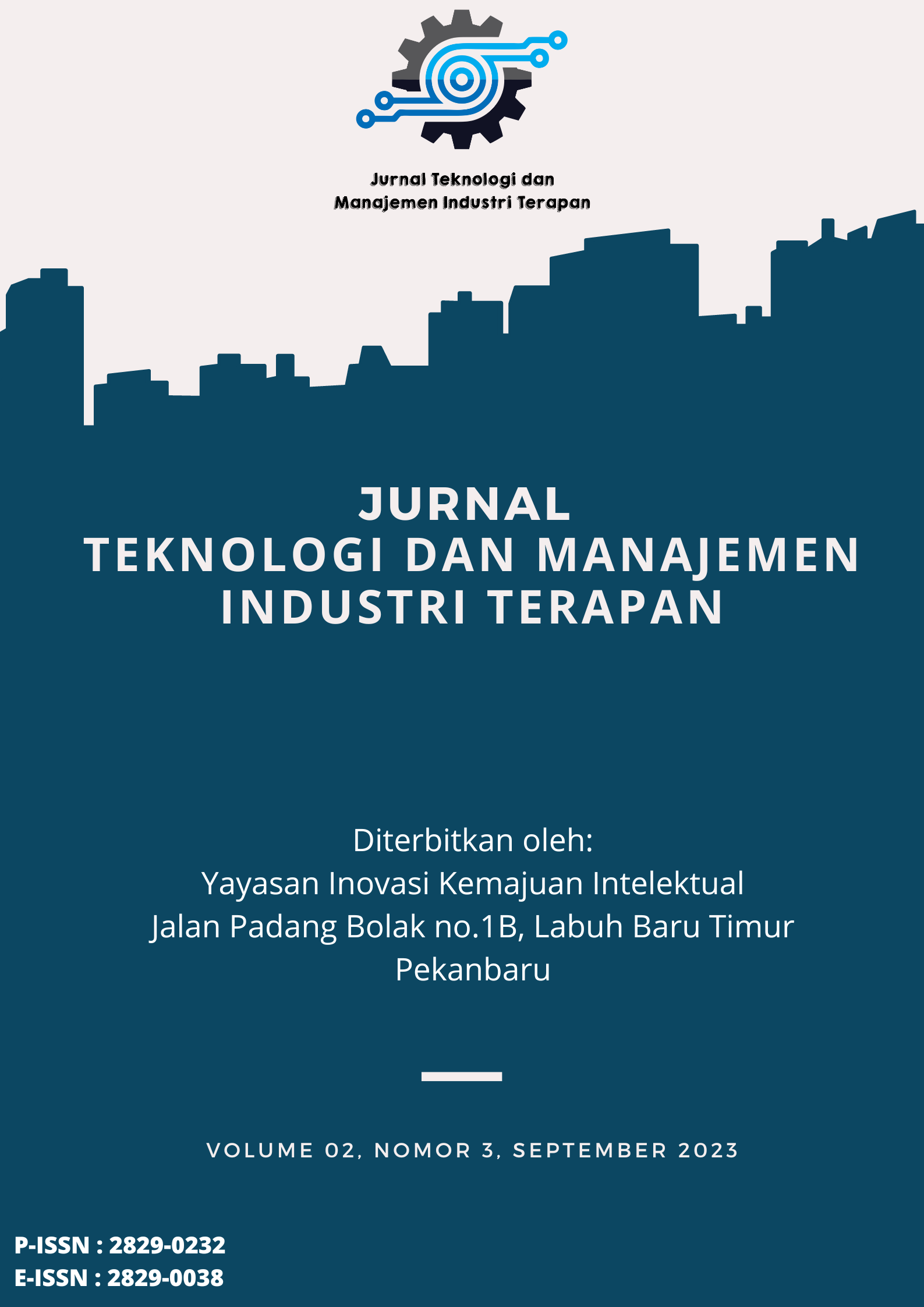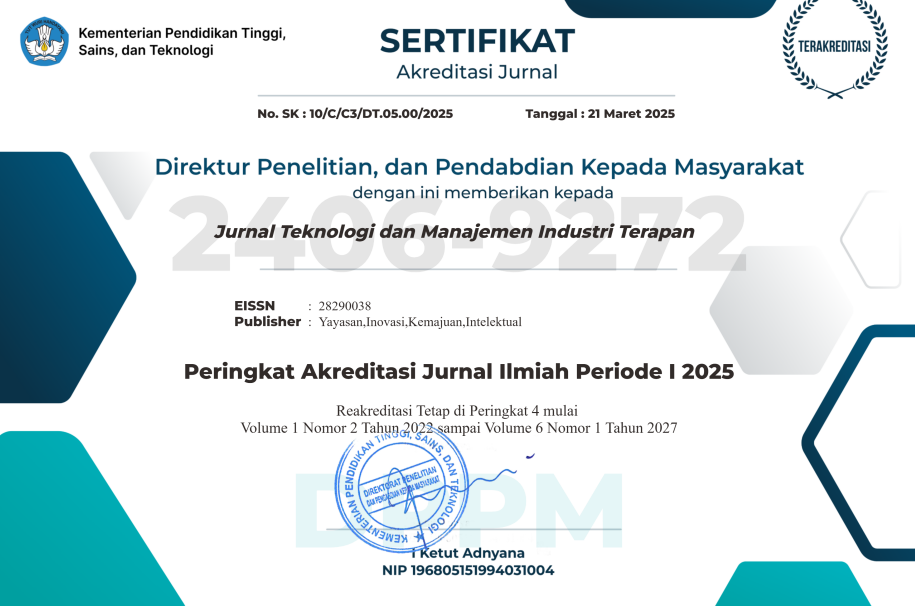Prediksi Harga Beras Belida Di Kota Pekanbaru Menggunakan Fuzzy Time Series Cheng
DOI:
https://doi.org/10.55826/tmit.v2i3.183Keywords:
Beras, Belida, Prediksi, FST ChengAbstract
Riau merupakan salah satu provinsi yang bukan basis produksi beras. Produksi beras lokal Riau hanya mencapai 242.000 ton/tahun dengan kebutuhan konsumsi beras mencapai 670.000 ton/tahun (BPS Kota Pekanbaru, 2021). Artinya 70 % kebutuhan beras Provinsi Riau dipenuhi dari luar daerah yakni Jawa Timur, Sumatera Barat dan Sumatera Selatan. Pendekatan penelitian yang digunakan adalah pendekatan penelitian kuantitatif. Menggunakan metode Fuzzy Time Series Cheng (FST Cheng) untuk menghasilkan hasil prediksi harga beras khususnya harga beras Belida di Kota Pekanbaru pada tahun yang telah ditentukan. Hasil penelitian yang diperoleh berupa prediksi menggunakan metode Fuzzy Time Series Cheng (FST Cheng) maka didapatkanlah 5 prediksi untuk harga pada tahun yang akan datang, yaitu pada tahun 2023 didapatlah prediksi harga beras Belida Sebesar kemudian, pada tahun 2024 dan tahun 2025 harga beras Belida tersebut stabil atau tidak terjadi kenaikan harga yaitu sebesar . Selanjutnya, pada tahun 2026 harga beras Belida tersebut kembali mengalami penurunan yang sangat signifikan yaitu sebesar dan pada tahun terakhir yaitu 2027 didapatlah prediksi harga beras Belida sama dengan prediksi harga di tahun 2026. Dengan MAPE atau error yang diperoleh sebesar 3,48% maka metode ini memiliki kinerja yang baik dalam memprediksi harga beras Beras di Kota Pekanbaru.
References
A.Febriyanti, “Penerapan Metode Fuzzy Time Series Chen Dan Cheng Dalam Peramalan Rata-Rata Harga Beras Ditingkat Perdagangan Besar (Grosir) Di Indonesia,” Skripsi. Fak. Mat. dan Ilmu Pengetah. Alam. Univ. Islam Indones. Yogyakarta, 2020.
S.Sulpaiyah, S.Bahri, andL.Harsyiah, “Peramalan Harga Beras dengan Metode Double Exponential Smoothing dan Fuzzy Time Series (Study Kasus: Harga Beras di Kota Mataram),” Eig. Math. J., pp. 58–69, 2022.
S.Sarbaini and N.Nazaruddin, “Pengaruh Kenaikan BBM Terhadap Laju Inflasi di Indonesia,” J. Teknol. Dan Manaj. Ind. Terap., vol. 2, no. I, pp. 25–32, 2023.
S.Sarbaini, “Perbandingan Penerapan Graf Kompatibel Dengan Realita Dilapangan Dalam Pengaturan Lampu Lalu Lintas Persimpangan Bandara Pekanbaru,” MAp (Mathematics Appl. J., vol. 4, no. 2, pp. 85–93, 2022.
S.Sarbaini and E.Safitri, “Penerapan Metode Single Exponential Smoothing dalam Memprediksi Jumlah Peserta Pelatihan Masyarakat,” Lattice J. J. Math. Educ. Appl., vol. 2, no. 2, pp. 103–117, 2022.
E. P.Cynthia et al., “Convolutional Neural Network and Deep Learning Approach for Image Detection and Identification,” in Journal of Physics: Conference Series, IOP Publishing, 2022, p. 12019.
D.Anggriani, “Perbandingan Model Chen Dan Model Lee Pada Metode Fuzzy Time Series Untuk Prediksi Harga Emas.” Universitas Islam Negeri Sultan Syarief Kasim Riau, 2012.
S.Sarbaini, E. P.Cynthia, F.Muttakin, andM. I.Arifandy, “Peningkatan Kompetensi Akademik Guru TK dan PAUD Melalui Pelatihan Google Classroom,” MENARA RIAU, vol. 17, no. 1, pp. 1–11.
S.Sarbaini, N.Nazaruddin, M.Rizki, M. I. H.Umam, M. L.Hamzah, andT. A.Prasetyo, “Radio Labeling of Banana Graphs,” BAREKENG J. Ilmu Mat. dan Terap., vol. 17, no. 1, pp. 165–170, 2023.
T. A.Prasetyo, R.Chandra, W. M.Siagian, T. H. J.Sihombing, andS.Sarbaini, “Implementation Of Brute-Force Algorithm and Backtracking Algorithm For Firefighting Robot Simulation,” KLIK-KUMPULAN J. ILMU Komput., vol. 10, no. 1, pp. 72–81, 2023.
S.Sarbaini, S.A.N.M., andG. L.Putra, “L(3,2,1) Labeling of Firecracker Graph,” J. Indones. Math. Soc., vol. 29, no. 1 SE-Articles, pp. 24–35, Mar.2023, doi: 10.22342/jims.29.1.1177.24-35.
R.Ariyanto, R. H.Tjahjana, andT.Udjiani, “Forecasting retail sales based on cheng fuzzy time series and particle swarm optimization clustering algorithm,” in Journal of Physics: Conference Series, 2021. doi: 10.1088/1742-6596/1918/4/042032.
A. F.Khofi, D.Arifianto, andI.Saifudin, “Perbandingan Model Chen Dan Model Lee Pada Metode Fuzzy Time Series Untuk Peramalan Harga Beras,” J. Smart Teknol., vol. 3, no. 2, pp. 140–146, 2022.
R.Mansor andB. J.Zaini, “Forecasting Using Point-valued Time Series and Fuzzy-valued Time Series Models,” Int. J. Membr. Sci. Technol., vol. 10, no. 2, pp. 244–250, 2023, doi: 10.15379/ijmst.v10i2.1168.
Y.-H.Lin, C.-M.Yu, J. Y.-T.Huang, andC.-Y.Wu, “The Fuzzy-Based Visual Intelligent Guidance System of an Autonomous Underwater Vehicle: Realization of Identifying and Tracking Underwater Target Objects,” Int. J. Fuzzy Syst., vol. 24, no. 7, pp. 3118–3133, 2022, doi: 10.1007/s40815-022-01327-7.
S.Othman andR.Mansor, “A comparison of chen and cheng fuzzy time series methods in energy-water efficiency forecasting at water treatment plant,” in AIP Conference Proceedings, 2022. doi: 10.1063/5.0093246.
I. M.Wirawan, I. A. E.Zaeni, U. A.Mujaddid, andA. S. B. M.Jaya, “Fuzzy Time Series Method Comparison of Chen and Cheng Models to Predict Chili Prices,” in 7th International Conference on Electrical, Electronics and Information Engineering: Technological Breakthrough for Greater New Life, ICEEIE 2021, 2021. doi: 10.1109/ICEEIE52663.2021.9616907.
M.Bettiza, “Forecasting Total Population Using Chen, Cheng, and Markov Chain Fuzzy Time Series Models,” in ICITEE 2020 - Proceedings of the 12th International Conference on Information Technology and Electrical Engineering, 2020, pp. 135–140. doi: 10.1109/ICITEE49829.2020.9271682.
Arnita, N.Afnisah, andF.Marpaung, “A Comparison of the Fuzzy Time Series Methods of Chen, Cheng and Markov Chain in Predicting Rainfall in Medan,” in Journal of Physics: Conference Series, 2020. doi: 10.1088/1742-6596/1462/1/012044.
S.Tricahya andZ.Rustam, “Forecasting the Amount of Pneumonia Patients in Jakarta with Weighted High Order Fuzzy Time Series,” in IOP Conference Series: Materials Science and Engineering, 2019. doi: 10.1088/1757-899X/546/5/052080.
M. L.Hamzah, A. A.Purwati, S.Sutoyo, A.Marsal, S.Sarbani, andN.Nazaruddin, “Implementation of the internet of things on smart posters using near field communication technology in the tourism sector,” Comput. Sci. Inf. Technol., vol. 3, no. 3, pp. 194–202, 2022.
S.Sarbaini, “Modeling of Traffic Flow Schemes at Road Intersections in Pekanbaru City Using Compatible Graphs,” Eduma Math. Educ. Learn. Teach., vol. 11, no. 2, pp. 213–222, 2022.
V.Devani, M. I. H.Umam, Y.Aiza, andS.Sarbaini, “Optimization of Tire Production Planning Using The Goal Programming Method and Sensitivity Analysis,” Int. J. Comput. Sci. Appl. Math., vol. 8, no. 2, pp. 36–40, 2022.
R.Raouf andS.Elsaieed, “Using Fuzzy Time Series Models to Estimate the Cost of Benefits of Egyptian Social Insurance System,” Int. J. Fuzzy Log. Intell. Syst., vol. 22, no. 2, pp. 169–182, 2022, doi: 10.5391/IJFIS.2022.22.2.169.
S.Othman, R.Mansor, andF.Ahmad, “Weighted Subsethood Fuzzy Time Series towards Energy-Water Efficiency for Water Treatment Plant,” Environ. Ecol. Res., vol. 10, no. 2, pp. 182–192, 2022, doi: 10.13189/eer.2022.100207.
Downloads
Published
Issue
Section
License
Copyright (c) 2023 Sarbaini Sarbaini, Devi Yanti, Nazaruddin

This work is licensed under a Creative Commons Attribution-NonCommercial-ShareAlike 4.0 International License.


















